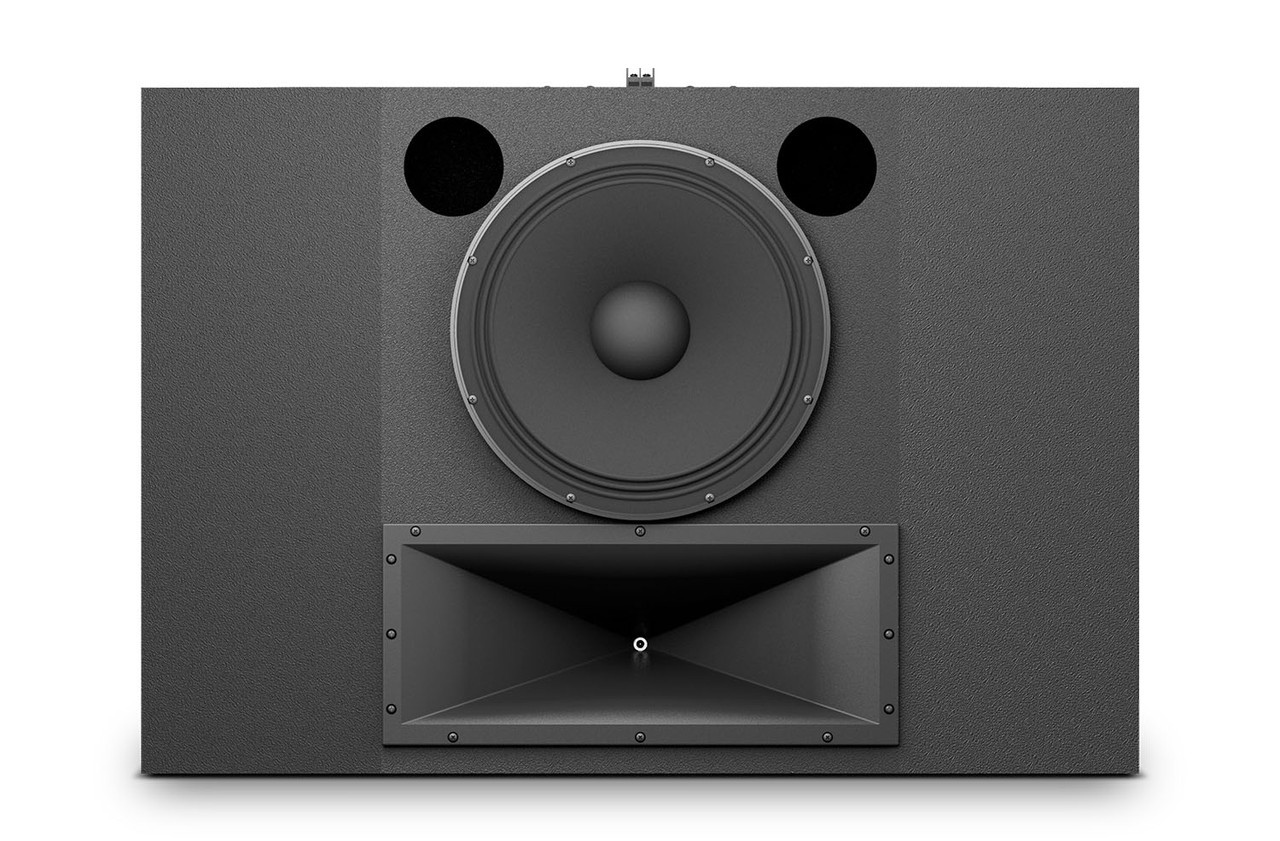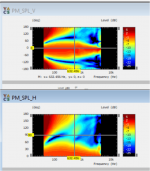The pressures dont get to meet.... :-/.... There is sound towards the waveguide from the woofer in dipole configuration and the sound would reflect and diffract like sound does.
...
//
If anyone wants to try (reminding you, DIY only) -
https://at-horns.eu/ext/ath-4.9.0-pre-230121.zip
https://at-horns.eu/ext/ath-4.9.0-pre-230121.zip
Code:
R-OSSE = {
R = 130.0
r0 = 12.7
a0 = 7.5
a = 39
k = 1.2
r = 0.3
b = 0.3
m = 0.8
q = 3.7
}
Rot = 3
; LF enclosure type "BEE"
BEE = {
Height = 500 ; [mm]
Radius = 125 ; [mm]
Depth = 250 ; [mm]
Source = 90 ; diaphragm radius [mm]
YOffset = -420 ; [mm]
ZOffset = 40 ; [mm]
; mesh resolution: top-front, top-back, bottom-back, bottom-front
Resolution = 20,30,50,50
; dipole opening
Port = {
z = 25 ; [mm]
w = 40 ; [mm]
wt = 15 ; wall thickness [mm]
Resolution = 35 ; [mm]
;Weight = 0.8 ; driving weight (default=1.0)
Damping = 0.5 ; interior wall damping
}
}
ABEC.SimType = 2
ABEC.MeshFrequency = 1000
ABEC.NumFrequencies = 40
ABEC.Abscissa = 1
ABEC.f1 = 50
ABEC.f2 = 5000
; don't mesh the waveguide
Mesh.WG = 0
Mesh.LengthSegments = 12
Mesh.AngularSegments = 64
Mesh.SubdomainSlices =
Mesh.WallThickness = 5
Mesh.VerticalOffset = 260
Mesh.ThroatResolution = 15
Mesh.MouthResolution = 20
Mesh.RearResolution = 20
Mesh.Quadrants = 14
ABEC.Polars:SPL_H = {
MapAngleRange = 0,180,37
NormAngle = 0
Distance = 2
}
ABEC.Polars:SPL_V = {
MapAngleRange = -180,180,72
NormAngle = 0
Distance = 2
Inclination = 270
}
Output.ABECProject = 1
Output.STL = 0
Report = {
PolarData = SPL_H
Title = BEE0
Width = 1600
Height = 900
}This is surprising to me, that's a two-way with a 15" woofer. According to datasheet the (horizontal) beamwdith is around 100 degrees nominal, which would mean the crossover won't be higher than about 1 kHz, rather even lower. Must be a fantastic driver (or they compromised the midrange seriously - I believe they didn't).
https://www.jblpro.com/ProductAttachments/JBL_C211_SpecSheet_8_18.pdf
If anybody is still interested, two and a half years after, the midrange is compromised indeed, and the crossover is not at 1 kHz, but an octave higher. When I first saw the measurements, I was really surprised by the remarkably even and wide horizontal polars up to 20 kHz. Several days later I've stumbled upon your brief discussion and realized this large horn is indeed driven by tiny 2409H. Interesting how -6 dB contour is growing wider, not more narrow, from 2 to 18 kHz. And what is this narrow spike at 1.8 kHz, I don't even. Too narrow to be diffraction, present in both planes, though more prominent in vertical. Strong box resonance escaping through ports? This horn seems to be interesting, but it's not very easy to separate horn features from overall design birth defects.Behind the rather straightforward waveguide of this JBL 2-way cinema speaker, the same 2409H is mounted as used in the 7-series.
Makes one wonder whether these 'interesting looking' Image Control Waveguides are merely marketing induced cosmetics.

https://www.spinorama.org/speakers/JBL C211/JBL/index_vendor.html
I'm not really intending the meh for PA, it's mostly to increase the (horizontal) directivity of a small horn.
Using the cardioid effect where the horn directivity looses it's potency.
The B&C6FHX51 has a 2" voice coil which gives plenty of space for a horn to be mounted.
However, making a Ø30cm horn go down to 200hz is a bit pointless to me.
Unless however there was a way to control it's directivity down to 200hz
This is a prototype I'm working on to figure out the midrange tap size and placement.
I mean - who doesn't want a Ø30cm controlled directivity horn down to 200hz 😀


Using the cardioid effect where the horn directivity looses it's potency.
The B&C6FHX51 has a 2" voice coil which gives plenty of space for a horn to be mounted.
However, making a Ø30cm horn go down to 200hz is a bit pointless to me.
Unless however there was a way to control it's directivity down to 200hz
This is a prototype I'm working on to figure out the midrange tap size and placement.
I mean - who doesn't want a Ø30cm controlled directivity horn down to 200hz 😀
Creative stuff, I love how additive manufacturing is changing things, suddenly anyone is capable doing industrial shapes with low cost! 🙂
Passive cardioid from that is tough I think, pick a point somewhere where you'd like to output the backwave and calculate/estimate path length for both the front and backwave. Theyd need to be quite close I think, back needs some low pass which adds some.
Coaxial like that, with smooth pattern, the waveguide/horn ends up being quite long and path length for the frontwave around mouth and back to where the woofer cone is is quite long. I think such long delay with acoustic low pass is hard to do so you'd probably need to extend path length of the backwave as well, perhaps bring it close to mouth. You could use some higher order system like two chambers before aperture, or, perhaps use some fancy material that delays sound and doesn't attenuate it too much. Fulcrum audio subs seem to have all these employed, result is long (suitably adjusted) delay and subcardioid pattern emerges.
Passive cardioid from that is tough I think, pick a point somewhere where you'd like to output the backwave and calculate/estimate path length for both the front and backwave. Theyd need to be quite close I think, back needs some low pass which adds some.
Coaxial like that, with smooth pattern, the waveguide/horn ends up being quite long and path length for the frontwave around mouth and back to where the woofer cone is is quite long. I think such long delay with acoustic low pass is hard to do so you'd probably need to extend path length of the backwave as well, perhaps bring it close to mouth. You could use some higher order system like two chambers before aperture, or, perhaps use some fancy material that delays sound and doesn't attenuate it too much. Fulcrum audio subs seem to have all these employed, result is long (suitably adjusted) delay and subcardioid pattern emerges.
Without the open top.
(Compare with https://www.diyaudio.com/community/...-design-the-easy-way-ath4.338806/post-7241986)




It's surprisingly wide horizontally.
(Compare with https://www.diyaudio.com/community/...-design-the-easy-way-ath4.338806/post-7241986)
It's surprisingly wide horizontally.
There's no turning back, I think. It will be all about the right damping.
My first guess is the " Cross Over Frequency: 1.8 kHz"And what is this narrow spike at 1.8 kHz, I don't even.
I agree. does the response change much if you push the slot back 20 or 30 mm; that would allow more damping between it and the cone.There's no turning back, I think. It will be all about the right damping.
Without the open top.
(Compare with https://www.diyaudio.com/community/...-design-the-easy-way-ath4.338806/post-7241986)
View attachment 1133012View attachment 1133015View attachment 1133013 View attachment 1133014
It's surprisingly wide horizontally.
This one makes me wonder how it would work, up-side-down with the waveguide being part of the enclosure (with sufficient round shapes for the top end like demonstrated a few pages ago. But it seems that having it be part of the enclosure plus the side firing cardioid vents beside the woofer could work.
If you use Ath, you can try that yourself with the provided script (#11,582), simply increase BEE - Port - z, that's the distance from the front baffle.does the response change much if you push the slot back 20 or 30 mm; that would allow more damping between it and the cone.
That model takes only a few minutes to solve.
Last edited:
should my vacs plots from unmodified script match your posts ? except for higher mesh frequencyIf you use Ath, you can try that yourself with the provided script (#11,582), simply increase BEE - Port - z, that's the distance from the front baffle.
That model takes only a few minutes to solve.
these look quite different, straight from VCAS except for Z axis range.
Attachments
also changed Z = 40 to Z = 80 and got exactly the same drawing image in abec and the identical polar map graphs...
Do you want to use a second (sub)woofer below for LF?There's no turning back, I think. It will be all about the right damping.
Yes. Could you upload your ABEC project?should my vacs plots from unmodified script match your posts ?
Yes.Do you want to use a second (sub)woofer below for LF?
ath.exe update - added option of the closed top, as shown in the above examples (BEE/Port/OpenTop=0):
https://at-horns.eu/ext/ath-4.9.0-pre-230122.zip
For a monopole (no opening) simply omit the "Port" section (it's enough to rename it, e.g. to "_Port").
https://at-horns.eu/ext/ath-4.9.0-pre-230122.zip
For a monopole (no opening) simply omit the "Port" section (it's enough to rename it, e.g. to "_Port").
Code:
BEE = {
Height = 500 ; [mm]
Radius = 125 ; [mm]
Depth = 250 ; [mm]
Source = 90 ; diaphragm radius [mm]
YOffset = -420 ; [mm]
ZOffset = 40 ; [mm]
Resolution = 20,30,50,50 ; mesh resolution: top-front, top-back, bottom-back, bottom-front
Port = {
z = 25 ; [mm]
w = 40 ; [mm]
wt = 15 ; wall thickness [mm]
Resolution = 35 ; [mm]
;Weight = 0.8 ; driving weight (default=1.0)
Damping = 0.5 ; interior wall damping
OpenTop = 0 ; default = 1
}
}If it works for Dutch&Dutch, I don't see a reason why it should not work for anyone else.This one makes me wonder how it would work, up-side-down with the waveguide being part of the enclosure (with sufficient round shapes for the top end like demonstrated a few pages ago. But it seems that having it be part of the enclosure plus the side firing cardioid vents beside the woofer could work.
In that case, you only give up the (narrow) vertical polars and perhaps some of the fidelity of the waveguide.
Last edited:
- Home
- Loudspeakers
- Multi-Way
- Acoustic Horn Design – The Easy Way (Ath4)
